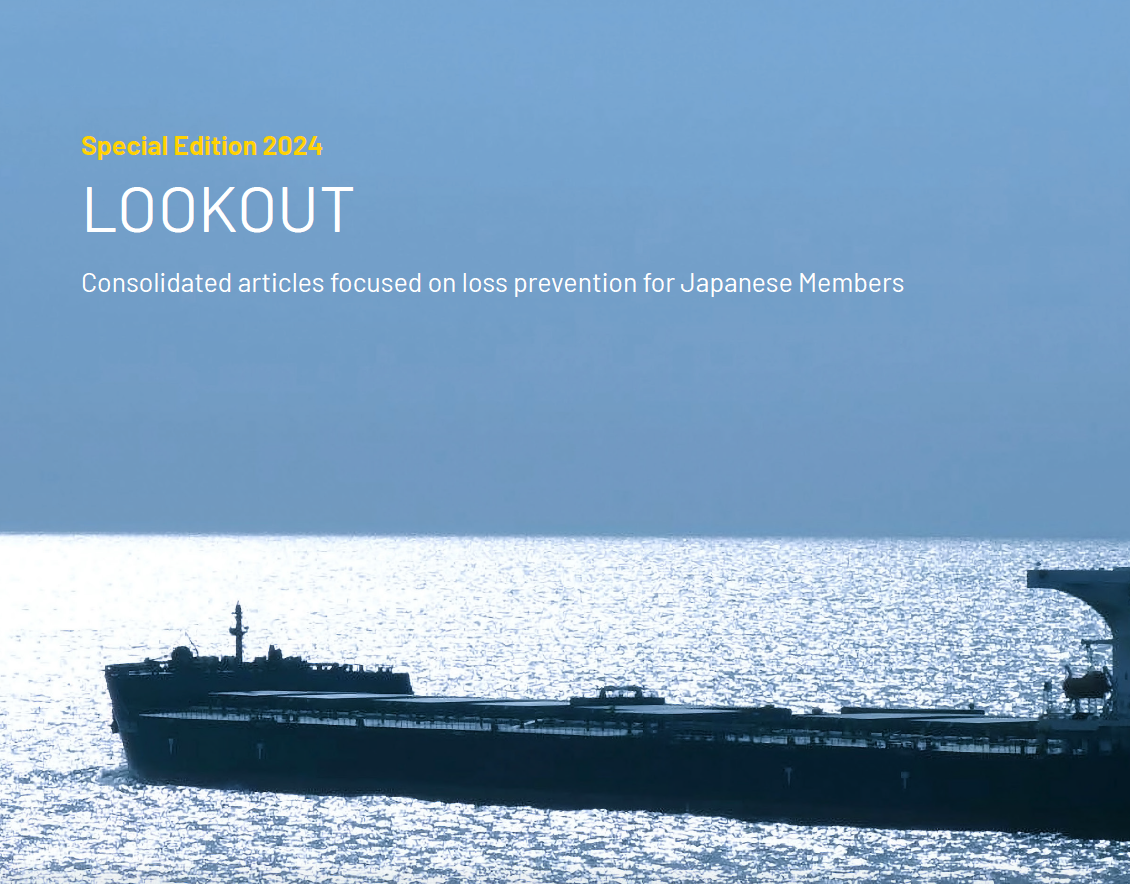Introduction and factors at play in machinery failure
The majority of casualties at sea are caused by a chain of failures occurring at the same time. Due to the nature of shipping and the heavy-duty equipment onboard, these casualties often involve some form of catastrophic machinery failure.This Risk Focus examines a number of serious incidents in the engine room that have resulted in significant engine damage and subsequent P&I claims.
Bringing it back to its basic definition, a machine is a tool containing one or more parts that use energy to perform an intended action. Factors affecting the performance of a piece of machinery are design, build quality, periodic maintenance, operators' handling, the quality of energy source and the operating environment.
A ship manager is in charge of the maintenance and handling of machinery. Still, their control is limited in that they can only manage remotely and must rely on the crew onboard to carry out the necessary tasks. Ship managers are responsible for managing vessels but don't have autonomy over the design or build quality of the machinery, meaning the operating environment can be a constant challenge. Additionally, the fuel on which the ship's engines run comes from the lowest rung of the crude oil refining process, creating additional burdens.
Further complicating the role of the ship manager are the substantial technological changes occurring within the maritime sector that mean decision making is continuously shifting ashore; with machinery and systems becoming plug-and-play black boxes, ship managers are fast becoming a channel between the ship and the manufacturers.
The adoption of new technology and appropriate crew training is also of significant concern. Major incidents have occurred due to lack of understanding of new technology introduced on a ship, for example, changes from paper charts to electronic charts, or conventional diesel engines to electronic engines. For a seamless transition, it's imperative to have a workable framework to adopt the changes well in advance, taking a very cautious approach and utilising risk assessment tools.
View the UK Club webinar on Catastrophic machinery failure: joining the dots.
Additional risks and mitigants
The role of the ship manager has always been to manage the unexpected, and this is increasingly the case. In these circumstances, the only way to handle the enormous uncertainty is to have well-trained, motivated staff, robust procedures and management systems to mitigate the risks.
Investing time and resources in hiring and retaining the right crew is essential to support the long-term success of a ship's management and prevent catastrophic failures. The industry can often associate retention rates with safer ships and cost-efficient operations. The most crucial staff are the top four ranks on board a vessel as they are the eyes and ears of the ship manager. They are the leaders who can carry and convey the ship manager's message to all onboard. The crew selection should not be left solely to the manning company, who would not know the demands of a particular vessel. Therefore, the involvement of the ship manager in the selection of crew is vital.
Working practices and attitudes onboard require careful and regular assessment. Transparent and clear management procedures are essential – the UK Club offers Members human element safety training with CAE at no cost. Strategies need to be vessel-specific, especially for plant maintenance systems and reporting functions. If they are too generic, the crew tend to follow individual methods and experience, leading to problematic situations.
A challenge which ship managers often face is the addition of a ship to their existing managed fleet. Usually, there are minimal records for the new takeover vessel, and unless the managers have a thorough takeover plan, problems and failures can occur. A robust system of feedback, data and incident sharing between different vessels and fleets will help pre-empt significant breakdowns, and this aspect is a cornerstone of good ship management.
Another essential aspect of safe ship operation is ensuring that the standby and emergency machinery are available when needed most. Availability of emergency machinery is vital to mitigate a failure onboard and ensure that the incident does not lead to a catastrophic failure. Therefore, a system of regular checks and routines for these standby machines, and firefighting and life-saving equipment is necessary. Practical and realistic drills onboard can prepare the crew for the unexpected, and a significant part of a ship manager's resources needs to be made available for this particular aspect.
The ship management standards vary from providing a skeleton infrastructure that fulfils the minimum class and statutory requirements, to advanced quality control where a manager has the freedom to provide the highest standards of ship management. A ship manager’s budget allowance plays a pivotal role in maintaining different standards and can be affected by charter hire for a particular ship or ship type.
Ship managers also face challenges in managing ships from different shipyards as the quality standard, maintenance approach and reliability standards vary. An established ship manager is better prepared to handle such issues as they have more flexibility to mould their operation to the vessel's needs and take additional measures to prevent failures. A separate budget might be required to deal with lower quality ships, which needs to be agreed and negotiated with the shipowner.
The following case studies indicate catastrophic failures and indicate the varied challenges faced by the ship managers. The ship manager's role is significant. It sometimes requires a precarious balancing act to keep the shipowner happy and take charge when the vessel's safety is under threat. Managing vessels despite having no control over the machinery used is difficult enough; simultaneously, the influence of technology means the job role itself is in a state of flux. Talented and effective ship managers are adept at fitting all the composite pieces of this demanding job together, allowing the crew to flourish, while maintaining high standards and establishing consistent and safety-conscious procedures onboard.
Allison due to main engine slow down in a narrow channel
A vessel was on a passage through a narrow channel. The pilot boarded and requested full ahead shortly after his arrival on the bridge. The Master asked the engine room to increase speed.
All was running smoothly for the next half an hour. Suddenly, a large amount of water was seen leaking from main engine unit number 6 around the cylinder jacket area. Engine room (ER) staff tried to isolate the leakage at unit number 6 but failed as the outlet valve was not holding. Due to the heavy leakage and low pressure on the cooling water system, the main engine (ME) automatic slowdown was activated.
The bridge team quickly considered all the options that would prevent the ship from colliding with the approaching bridge. The team’s efforts were futile as the loaded vessel was not moving at sufficient speed to maintain steerageway. Within a few minutes, there was an allison with significant impact and the bridge centre pillar fendering was splintered.
The water leakage from unit number 6 was identified from a crack on the cylinder cover cooling jacket. Often such cracks are associated with insufficient cooling water maintenance. In such cases, heavy deposits of dirt and metallic particles i.e. rust are found in the system. Deposits are brought in by the circulating cooling water and tend to find their way into the clearances between the cylinder cover and the cooling jacket. This makes heat expansion of the cylinder cover impossible without exposing the cooling jacket to significant stress. Thus, insufficient cooling water treatment, combined with the heavy corrosion of the engine components, can also cause the cooling water jacket to crack.
It is important to ensure that the valves are holding so that a particular unit can be isolated quickly. Additionally, like fuel oil and lubricating oil, the engine cooling water is a medium which must be carefully selected, treated, maintained and monitored.
Engine room fire leading to loss of propulsion at sea
During a vessel's loaded passage and while the ER was operating unmanned, a loud noise was heard from the ER which was followed afterwards by a fire alarm. The third engineer went to investigate and found that the ER was filled with black smoke and flames were emanating from the fuel injection valve on number 2 cylinder unit of the ME.
The third engineer informed the bridge and requested to stop the engine. The standard emergency procedures were followed, and after confirming all crew were out of the engine room, the CO₂ fire extinguishing system was activated, and the fire extinguished.
Although the ME had not suffered much damage during this incident, the control systems, electrical wiring, and panels were severely heat damaged which led to a loss of propulsion and an expensive towage, followed by extensive repairs at a lay berth.
Investigations revealed that two threaded studs that hold the fuel injection valve in place had sheared at the root of the thread. This type of failure is common when nuts are overtightened, causing the threads to stretch, eventually leading to fatigue failure.
The correct way to secure these nuts is by using a calibrated torque wrench and to tighten the nuts using the manufacturer’s recommended torque.
It is also important to note that there are different designs for securing the fuel injection valves. Some vessels are provided with spacers with a spring-loaded arrangement: for these, there is no risk of overtightening if the hand tightening procedures are followed; a torque wrench is not required.
Watch ‘Inside ship: shielding of hot surfaces’
Watch ‘Catastrophic fires: phone-a-friend with Richard Gunn’
Damaged main engine bearing
A bulker loaded a full cargo of soya beans from Brazil and sailed for China.
A few days into the voyage, the oil mist detector alarm on the ME activated which caused an automatic slowdown of the ME. The engine was stopped, and later on, inspected, but no issues were found. The Chief Engineer assumed that this was a false alarm. The ME was restarted, and the ship continued with her voyage.
A day later, a loud 'bang' and the sound of metal knocking was heard from the ER and the engine was stopped. Upon investigation, the crankpin bearing for one of the cylinders was found damaged. A decision was made to isolate the cylinder and run the engine on the remaining units.
The vessel arrived on her own power in South Africa, and a detailed inspection took place where further damage to the engine was established. The damage had extended to other ME units, and many of the bearings were damaged and scored, including the crankpins for some units.
Lengthy ME repairs followed. The cargo had to be transferred to another ship in order to minimise the possible cargo claims.
Main engine damage due to CAT fines in fuel
A vessel was chartered to perform a loaded voyage from the Persian Gulf to Eastern Australia.
Catalytic fines (cat fines) are particles of spent aluminium and silicon catalyst that arise from the fuel refinery's catalytic cracking process. The cat fines are in the form of complex alumino-silicates and, depending on the catalyst used, vary both in size and hardness. Engine manufacturers generally recommend a maximum 15 ppm level of cat fines in the fuel entering the engines. As this level is significantly lower than the specification levels specified in the ISO standards (8217:2017), it is essential to ensure adequate fuel handling and purification equipment, and procedures are in place onboard to effectively bring the levels of cat fines in the fuel below 15 ppm.
This vessel was using fuel bunkered during her passage to the loading port. The bunker analysis reports for the fuel were available onboard. The cat fines’ content of the fuel, although within the parameters of the ISO 8217:2017 specifications, were high- 54 ppm. As cat fines are very hard, they can become embedded in the softer metal surfaces of cylinder liners, piston grooves and rings, thereby damaging these parts. All other fuel parameters were within specifications.
The vessel encountered bad weather while in the Arabian Sea. After four days into the voyage, high exhaust gas temperatures and under piston temperatures were encountered for two ME units. The ME was stopped for inspection. During this inspection it was found that all piston rings of unit number 3 were broken. It was also noted that there was evidence of heavy scuffing on the piston rings of all the other units.
The vessel deviated to Singapore at slow speed by cutting off unit number 3. In Singapore, manufacturer approved maintenance contractors attended the vessel upon arrival at the anchorage to evaluate the breakdown and support the onboard team.
The condition of all liners, pistons and rings was checked via scavenge ports. Different grades of scuffing were found on all units. Piston rings were found broken for many units. Surface cracks were also noted on most cylinder liners.
The vessel was held up for seven days for carrying out repairs and cleaning fuel tanks. A costly dispute followed between the owners and charterers, and several glaring issues were found in the bunker planning, sampling process, fuel storage and handling onboard.
Read the UK Club article on VPS Bunker Data - availability, quality and compliance of bunker fuel supply
Read the UK Defence Club publication on Bunkers: A Guide to Quality and Quantity Claims
Heavy corrosion in hull bottom plating
After a vessel’s delivery, she was placed under an extended drydocking program which allowed two consecutive bottom surveys to be carried out afloat. The vessel's hull coating consists of a primer and an antifouling coat. Further, the vessel is equipped with an Impressed Current Cathodic Protection (ICCP) system. ICCP systems are a technologically advanced and long-term solution to hull corrosion problems and are regarded as superior to sacrificial anode systems. A remote monitoring panel in the engine control room is provided where ICCP parameters should be regularly monitored and logged daily by the ship’s engineers. Any abnormalities should be promptly investigated.
The vessel was finally drydocked after seven years, and during dock inspection, the hull thickness measurements were taken.
- Considerable corrosion damage in the bottom hull plating was noted.
- Thickness measurements revealed a material thickness reduction of more than 25% in many keel plate areas, the flat port bottom and the bilge radius.
- Many welding seams in those areas showed material loss due to corrosion of more than 3.5mm depth.
These findings led to a class requirement for a renewal of almost 120 tons of bottom steel plating. Since the heavy corrosion found during the dock inspection seemed abnormal, the owners ordered the ICCP system makers to inspect the ICCP system. During this inspection, it was noted that the ICCP system had not been operating correctly for a long time.
The hull damage led to substantial steel renewal costs and loss of hire for an additional three weeks in drydock. This led to various further counterparty claims.
Negligent work by contractors (divers) leading to engine room flooding
Ship managers had made arrangements for maintenance work on various underwater portions of a ship’s hull including the starboard side sea chest valve during a vessel’s stay at anchorage. This work required a professional diving company's services to perform the inspections and blank the seawater ingress into the engine room, whilst the sea chest valve lid was removed, inspected, cleaned and re-installed by the ship's crew.
The divers attended the ship and inflated a marking buoy inside the seawater inlet pipe to isolate the seawater entry, in preparation for the removal of the valve lid. The crew, following the instructions of the diving supervisor, waited for the water pressure to reduce.
After some time, the lid was loosened, and the crew started to remove the sea chest valve's lid. Shortly afterwards the buoy collapsed, causing a rapid ingress of seawater into the engine room.
The diving company did not have a contingency plan to substitute the collapsed buoy. As a result, the engine room started flooding with seawater. The crew immediately attempted to replace the valve cover, but this was unsuccessful. Due to the ingress rate, the engine room continued to fill with seawater despite the crew's effort to pump it out. The water level eventually reached the generators and caused electrical failure and blackout. The Master immediately notified the relevant local authorities and requested immediate assistance.
Tugs assisted in shifting the ship to the shipyard. Permanent repairs and thorough cleaning took place at a lay berth, including replacement of electrical motors affected by the flooding, repair of electrical control panels, inspection and replacement of many items of seawater damaged machinery.
Boiler flame failure resulting in serious injury to the crew
Over two days at anchor, the boiler of a product tanker was not firing reliably. The crew opened and cleaned the burner unit and adjusted the igniter electrodes twice, but after the second attempt, the heater refused to fire.
On the third day, the second engineer discussed the remedial action plan with the crew. They opened up the burner unit and cleaned the burner and igniter electrodes again. This time, the boiler operated for approximately 30 minutes, after which it again failed to ignite. The electrician re-inspected the electrical systems. Simultaneously, the third engineer and fifth engineer dismantled and cleaned the burner and nozzle unit, reassembled it under the second engineer's supervision and refitted it to the boiler one more time. When the test-firing commenced, the third engineer, fifth engineer and electrician positioned themselves near the boiler burner to monitor the automatic starting and firing sequence. The forced-draught fan went through a five-minute purge programme, followed by a massive explosion when the igniter electrodes sparked.
The burner arrangement was ripped apart due to the explosion. The ducting from the forced-draught fan was also ruptured. Fuel lines running across the top of the burner were deformed, and some began to spill oil. The engineers and electrician standing near the boiler suffered severe burns over large portions of their bodies.
Ice blockage in the low sea chest suction
A container carrier was entering icy waters. In preparation, the engineering staff completed an ice navigation checklist and, among other things, opened the steam valve to the lower sea chest as they thought this would prevent ice build-up.
During the night, the officer of the watch noticed a rise in temperature in the freshwater cooling system. He called the second engineer, who attributed the rise in temperature to an ice blockage in the low sea chest suction. Arrangements were made to use water from the forepeak ballast tank to lower the cooling water temperature.
To clear the ice, engine staff unbolted the cover of the housing containing the low seawater strainer. As the crew were working, they noticed water beginning to overflow from the seawater strainer housing. They attempted to tighten the valve by hand but could not do so; a pry bar was then used, but the valve operating mechanism failed. Hydrostatic pressure forced the valve disc and valve operating mechanism upwards, allowing seawater to enter uncontrolled and overflow into the ER.
Multiple attempts to secure the cover on the seawater strainer housing were made but were unsuccessful. Within approximately ten minutes, the engine room's water was nearly 4m deep and had reached the level of the grating deck. After electrical sparks were seen, the Master ordered that the vessel be blacked out and the engine room evacuated.
Soon afterwards, the crew were mustered on the upper deck and briefed on the situation. The emergency generator was started and put on the line, and the crew readied for possible abandonment. Despite having anchors down, the vessel drifted and grounded. The hull sustained tears, punctures and dents. The engine room machinery and electrical components located below the flooded waterline were all rendered inoperable.
Shipbuilding defect
Vessel owners entered into a charter of a new build platform supply vessel. Shortly thereafter, the owners entered into a shipbuilding contract with a shipyard in Vietnam for the construction and delivery of the vessel. The vessel's engine manufacturer was one of the shipyard’s subcontractors for the purposes of the shipbuilding contract.
Subsequently, the owners took delivery of the vessel, and the vessel went on hire.
During operations offshore, the vessel's port inboard main engine failed with extensive damages to the crankshaft and bearings. Steps were immediately taken to bring in representatives from the engine manufacturers and shipyard to assess the problem. It transpired that the problem could not be remedied on site, so the engine had to be removed from the vessel for overhaul in a shore workshop before reinstallation. The breakdown was caused by an incorrect pipe layout by the shipyard, which was not picked up by the engine manufacturers when commissioning the vessel's engines.
The breakdown ultimately led to the charterers terminating her long-term charter party. The owners disputed the termination and both sides engaged in a long-lasting legal dispute.
The full risk focus publication is available to download below.





